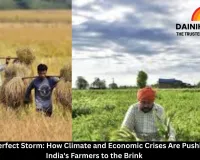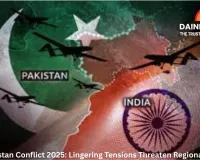India's Economic Abyss: Unemployment, Deflationary Pressures, and Crushing Debt Demand Urgent Reforms
Digital Desk
In the shadow of a resurgent global economy, India grapples with its own unraveling crisis. Unemployment rates hovering at 5.6% a stubborn marker of labor market distress coupled with deflationary pressures in food prices and a national debt burden at 82% of GDP threaten fiscal stability.
Recent Reserve Bank of India data reveals household debt has surged by over 23% in the past two years, with per capita borrowing climbing from Rs.3.9 lakh in 2023 to Rs.4.8 lakh by March 2025.
This isn't abstract economics it's families forgoing essentials, postponing healthcare, and watching aspirations crumble under loan repayments and stagnant wages. As youth unemployment lingers above 16%, it's imperative to dissect the policy missteps fueling this turmoil and advocate for equitable revival.
The origins of this downturn lie in reforms that promised progress but delivered pain. Demonetization in 2016, touted as a blow to illicit cash, devastated the informal economy, employing 90% of workers.
Businesses collapsed, migrants fled without jobs, and GDP contracted by 2%. The 2017 Goods and Services Tax (GST) aimed to streamline levies but its multi-tier structure and red tape have choked micro, small, and medium enterprises (MSMEs).
Compliance expenses have soared, with 40% of small units facing 20-30% revenue erosion. The 2020 farm laws, pitched as farmer empowerment, sparked massive protests by risking rural livelihoods to unchecked corporate influence sans safeguards.
Though repealed, their shadow endures in agrarian despair, where Maharashtra alone reported 2,635 farmer suicides in 2024—a grim toll amid crop failures and debt spirals.
These fumbles have widened India's wealth chasm to canyon proportions. The top 1% commands over 40% of national wealth, according to Oxfam's latest insights, while the bottom 50% clings to under 3%. This isn't happenstance; it's policy favoritism.
The 2019 corporate tax slash from 30% to 22% gifted trillions to tycoons, yet benefits rarely trickle down. The middle class, meanwhile, grapples with regressive GST on basics like soap and sanitary products at up to 28%. Household debt's 23% leap stems not from extravagance but desperation—high-interest survival loans amid flat incomes.
Food deflation at -0.69% in August 2025 offers fleeting relief, but overall CPI at 1.54% in September signals weakening demand, not robust growth. For 800 million surviving on less than $3 daily, this masks eroding real incomes.
The debt snare binds households and the state alike. Public liabilities at 82% of GDP, per IMF alerts, court credit downgrades and pricier loans. Unchecked, it risks a vicious cycle of austerity battering the poor.
The cure demands progressive taxation and sweeping reforms. A 2% wealth levy on fortunes above Rs.10 crore could harvest Rs.1.5 lakh crore yearly for employment-boosting infrastructure.
Streamline GST to a flat 12% slab, unburdening small firms. Bolster farm cooperatives with inflation-linked minimum support prices, fortifying rural earnings. Harness solar ambitions for 10 million green jobs by 2030.
From protest fields to corporate towers, the call rings clear: reform or risk collapse. With 65% of Indians under 35, they crave substance over slogans an economy elevating everyone, not just elites. As Diwali glows this season, let's pledge a future where abundance is shared, not hoarded. Time is fleeting; action is essential.





.jpg)
.jpg)
.jpg)
.jpg)
.jpg)
.jpg)
